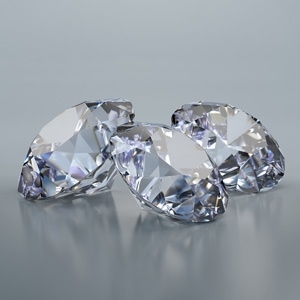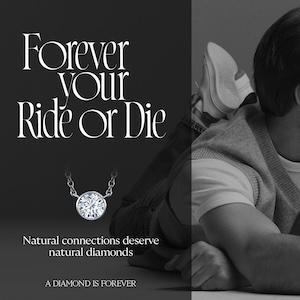
Online sales, branded diamonds, and female self-purchases all scored big gains in 2021, according to De Beers’ latest Diamond Insight Report.
The company’s research, based on a survey of 18,000 U.S. women, estimates U.S. natural diamond jewelry sales hit $47 billion in 2021, a 34% leap from the prior year.
The report also found:
– Branded diamond jewelry represented two-thirds of all diamond jewelry purchases in the United States in 2021, more than double the percentage in 2015. It also comprised almost 80% of all sales by value.
Younger consumers embraced branded diamonds more than their elders: 76% of diamond jewelry purchases by Gen Z consumers were branded, compared with 64% for Gen X and only 38% for baby boomers.
The survey didn’t say what constitutes a brand, which was deliberate, says Esther Oberbeck, De Beers’ senior vice president of strategy and analytics.
“We let consumers define what a brand is,” she says. “There’s a wide range of what registers as a brand.
“What’s really interesting is, for the younger generation, the number self-reporting that they’re buying a brand is over 60%. What we’ve learned is people really want [their diamond jewelry] to be branded. Whether we consider it a brand or not, we found it very important to allow people to express their preference for brands.”
Younger people favor brands because they “are a vehicle of self-expression, for a generation that seeks self-expression, be it in identities, or a sense of achievement or entrepreneurship, or community, or how they want to present themselves to the world,” she says.
– Online sales of diamond jewelry represented 25% of U.S. sales by value and 31% by volume in 2021. In 2015, online represented only 14% by value and 18% by volume.
Online purchases accounted for 42% of purchases from Gen Z consumers; 40% of self-purchased items; and 37% of purchases by single women. In addition, 54% of online purchases in 2021 were from people buying diamond jewelry for the first time.
Of course, that was in part fueled by the pandemic, but Oberbeck believes it will become the new status quo.
“The new generations don’t make that much of a distinction [between online and offline],” she says. “If you are in a store, you look at the store’s website. Some people who research online buy in store. It is this seamlessness, this online and offline worlds joining together, that is the real trend, particularly in the U.S.”
De Beers Brands CEO Marc Jacheet agrees we’re seeing a long-term shift.
“The best performing brands in the world are phygital,” he says. “I would not be surprised if we see, in the coming years, Gen Z shopping more online than physical, and shopping more through social media platforms than proprietary platforms, just given the rate of acceleration and the trends that we see.”
He thinks that the technology behind Web3—the metaverse, virtual reality—will cause a big shift in our lives.
“There will be more and more time spent in the digital world than the physical world,” Jacheet says. “This is already the case at work, where we see across the world, people spending three days in the office, which is completely new compared to three years ago. That means that the time spent on digital tools is only going to grow.”
He believes the metaverse “will enable [companies] to create and compare in 3D. It will enable us to transport our clients to the place of discovery—in the process of cutting and polishing, in the design phase, in the jewelry manufacturing—and not in a generic way, in a unique, personal, and engaging way. It will enable you to create a virtual experience that is much more immersive, much more creative, and 3D.”
Jacheet says that the best brands are trying to “gamify” the shopping experience: “We see gamification everywhere, in learning and buying. People are much more receptive when the experience is enjoyable.”
– The biggest gain in diamond jewelry sales was from the female self-purchase category.
“Female self-purchase is something that has been happening in the last decade and has accelerated through the last few years,” says Oberbeck. “The purchasing power of women has come to the fore.”
The report also found that younger consumers increasingly want ethical assurances about the products they buy.
Overall, 36% of women and 39% of Gen Z now specifically seek information on a brand’s ethical credentials before buying diamond jewelry, it said. Some 40% of women said that knowing their diamonds had a positive impact on local mining communities would make them more likely to buy; this number rose to 50% among Gen Z consumers.
“How many brands are talking about where their products come from?” Oberbeck asks. “Not everybody does. It’s such a simple thing. This is a call to action for the industry to review their social media and their website and ask themselves: Am I telling the product’s story the way it deserves? Because it makes a difference.”
As far as holiday sales, she says it’s a “bit early” to say.
“Geopolitically and economically, things are changing week to week,” she says. “The indications currently are it shouldn’t be totally negative. We have desirability for the product. Hopefully, we’ll be surprised on the upside.”
Photo: Getty Images
Follow JCK on Instagram: @jckmagazineFollow JCK on Twitter: @jckmagazine
Follow JCK on Facebook: @jckmagazine





